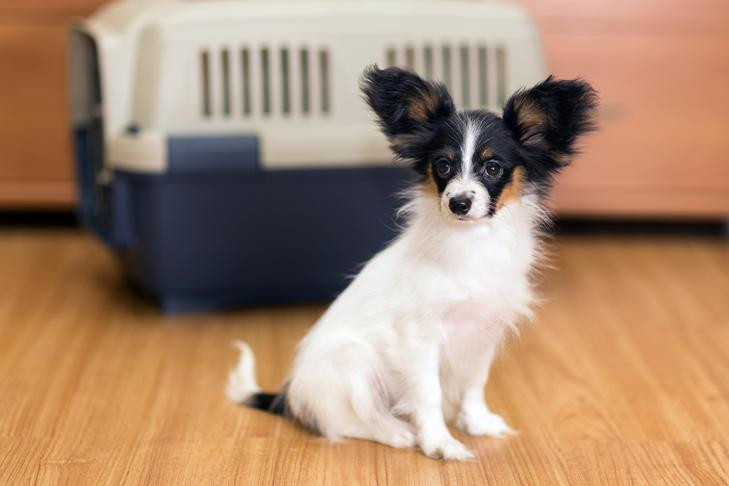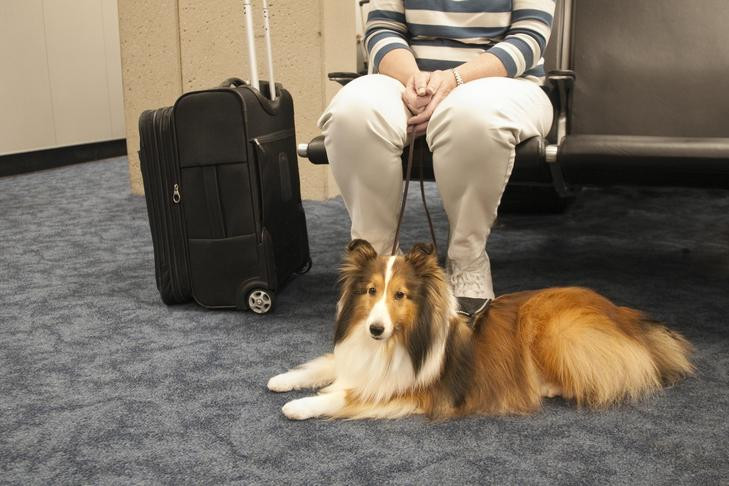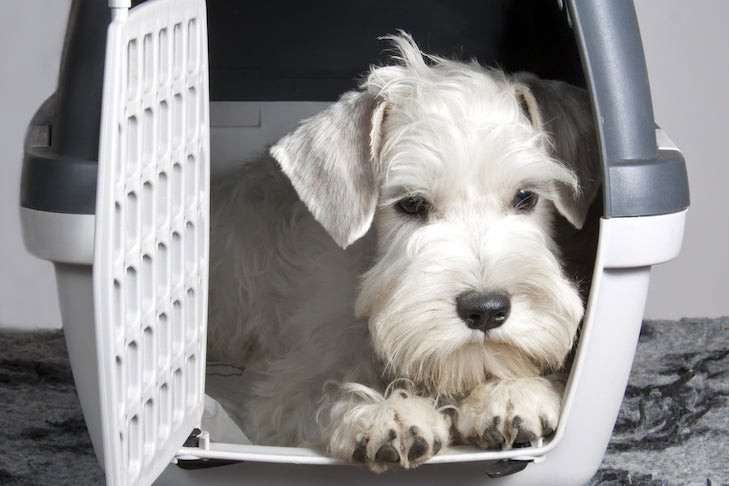Flying with your dog in the cabin can be a rewarding experience, ensuring your furry friend’s comfort and safety throughout the journey, and flyermedia.net is here to guide you through every step. By understanding airline policies, preparing your dog, and packing the essentials, you can make the trip enjoyable for both of you. This article provides detailed insights and tips to help you navigate the process seamlessly, focusing on domestic travel, international regulations, and breed restrictions.
1. Is Flying With My Dog In The Cabin A Good Idea?
It depends on your dog’s temperament, health, and the length of the flight. According to Dr. Jerry Klein, Chief Veterinary Officer for the American Kennel Club, air travel can be stressful for both people and dogs due to unfamiliar sounds, sights, and smells. To ensure your dog can fly safely, consider their physical and mental well-being, and consult with your vet about whether air travel is appropriate.
Flying can indeed be a good option if your dog is small, well-behaved, and fits comfortably in an airline-approved carrier under the seat. For larger dogs, it might be more challenging and potentially stressful. Direct flights are preferable to minimize layovers and handling, reducing stress. According to a study by the American Veterinary Medical Association (AVMA), proper planning and preparation are crucial for a successful and stress-free flight with your pet.
Here’s a quick checklist to consider:
- Temperament: Is your dog generally calm and adaptable to new environments?
- Health: Does your dog have any pre-existing health conditions that could be exacerbated by air travel?
- Size: Can your dog comfortably fit in a carrier under the seat?
- Flight Duration: Is the flight short enough to minimize stress on your dog?
 Papillon sitting indoors with a traveling crate in the background.
Papillon sitting indoors with a traveling crate in the background.
2. How Do I Prepare My Dog For Flying In The Cabin?
Start by acclimating your dog to their carrier well in advance of the trip. The key is to make the carrier a comfortable and safe space, turning it into a home away from home. According to the Humane Society, familiarizing your dog with the carrier can significantly reduce their anxiety during travel.
2.1 Carrier Acclimation
- Introduce the Carrier Gradually: Place the carrier in a frequently used area of your home.
- Make it Comfortable: Add soft bedding, toys, and familiar items with your scent.
- Positive Reinforcement: Use treats and praise when your dog enters the carrier.
- Short Periods: Start with short periods inside the carrier, gradually increasing the time.
- Simulate Travel: Take short car rides with your dog in the carrier to get them used to the motion.
2.2 Socialization and Training
- Exposure to Crowds: Take your dog to dog-friendly places with lots of people and sounds.
- Basic Obedience: Ensure your dog knows and responds to basic commands like “sit,” “stay,” and “quiet.”
- CGC Title: Consider earning your dog’s Canine Good Citizen (CGC) title to ensure they are well-behaved in public settings.
- Airplane Simulation: Some trainers set up mock airplane environments to help dogs practice sitting quietly under a seat.
2.3 Health Check and Paperwork
- Veterinary Appointment: Schedule a check-up to ensure your dog is healthy enough to fly.
- Vaccinations: Ensure your dog is up-to-date on all required vaccinations.
- Health Certificate: While not always required for domestic flights, it’s good to have a health certificate from your vet.
- Medications: Pack any necessary medications, including flea and tick preventatives.
3. What Are The Airline Requirements For Flying With A Dog In The Cabin?
Each airline has specific rules about breed, carrier size, and fees, so it’s important to check before you book. Most airlines allow small dogs to fly in the cabin if they are in an approved carrier that fits under the seat. However, there are restrictions on the number of pets allowed per flight and specific requirements for health documentation and carrier dimensions.
According to the International Air Transport Association (IATA), carriers should be well-ventilated, leak-proof, and large enough for the dog to stand, turn around, and lie down comfortably. It’s also essential to book in advance, as space for pets in the cabin is limited.
Here’s a breakdown of requirements for some major U.S. airlines:
| Airline | Cabin Allowed? | Carrier Size Restrictions | Fees (USD) |
|---|---|---|---|
| Alaska Airlines | Yes | Varies by aircraft; check with airline | 100 |
| American Airlines | Yes | Must fit under the seat | 150 |
| Delta | Yes | Must fit under the seat with ventilation on 3-4 sides | 95-200 |
| Frontier | Yes | Must fit under the seat, allowing the dog to stand and turn around | 99 |
| Hawaiian Airlines | Yes | Pet and carrier combined cannot exceed 25 pounds | 35-125 |
| JetBlue | Yes | Combined weight of dog and carrier must be no more than 20 pounds | 125 |
| Southwest | Yes | Must fit under the seat; limited to 6 pets per flight | 125-35 |
| Spirit | Yes | Combined weight of dog(s) and carrier cannot be more than 40 pounds; domestic flights only | 125 |
| United | Yes | Varies by aircraft; check with airline | 125 |
 Shetland Sheepdog service dog laying next to its owner at the airport.
Shetland Sheepdog service dog laying next to its owner at the airport.
4. What Do I Need To Pack When Flying With My Dog In The Cabin?
Packing the right supplies can ensure your dog is comfortable and safe during the flight. Essential items include proof of vaccinations, an airline-approved carrier, food, water, bowls, treats, waste bags, and pet wipes. Additionally, consider bringing a familiar toy or blanket to help your dog feel more secure.
According to the American Society for the Prevention of Cruelty to Animals (ASPCA), having these items readily available can help manage your dog’s needs and reduce stress during travel.
Here’s a detailed packing list:
- Proof of Vaccinations: Include health certificates and rabies vaccination records.
- Airline-Approved Carrier: Ensure it meets the airline’s size requirements and is well-ventilated.
- Food and Water: Pack enough food for the trip, plus extra in case of delays, and a collapsible water bowl.
- Treats: Bring your dog’s favorite treats for positive reinforcement and comfort.
- Waste Bags: Essential for cleaning up after your dog.
- Pet Wipes: For quick and easy cleanups.
- Familiar Toy or Blanket: Helps your dog feel secure and comfortable.
- Medications: Include any prescription medications, flea and tick preventatives, and motion sickness remedies if prescribed by your vet.
- First-Aid Kit: Include basic supplies like bandages, antiseptic wipes, and any specific items recommended by your vet.
- Identification: Ensure your dog has a collar with ID tags and a microchip.
5. What Happens At The Airport With My Dog?
At the airport, you’ll need to go through security and find a pet relief area. During security screening, you’ll need to remove your dog from their carrier, walk them through the metal detector (or request a pat-down), and send the carrier through the X-ray machine. Most airports have designated pet relief areas where your dog can relieve themselves before the flight.
According to the Transportation Security Administration (TSA), it’s important to arrive early to allow extra time for the security process. Once through security, keep your dog in their carrier as much as possible, except when in designated pet relief areas.
Here’s what to expect at the airport:
- Check-In: Confirm your dog’s travel arrangements with the airline.
- Security Screening: Remove your dog from the carrier, walk them through the metal detector, and send the carrier through the X-ray machine.
- Pet Relief Area: Allow your dog to relieve themselves in a designated area.
- Waiting at the Gate: Keep your dog in the carrier and be mindful of other passengers.
- Boarding: Follow the airline’s instructions for boarding with your pet.
6. What Happens During The Flight With My Dog?
During the flight, your dog must remain in their carrier under the seat in front of you. It’s helpful to give your dog a chew toy or familiar item to keep them comfortable and calm. Avoid feeding your dog a large meal right before the flight to prevent motion sickness.
According to airline policies, dogs are not allowed to sit on their owner’s lap or roam freely in the cabin. Turbulence and pressure changes during takeoff and landing can be stressful, so providing a comforting presence and familiar items can help ease their anxiety.
Here’s how to manage your dog during the flight:
- Keep Your Dog in the Carrier: Ensure they stay safely inside the carrier under the seat.
- Provide Comfort: Offer a favorite toy, blanket, or chew toy to keep them occupied.
- Stay Calm: Your dog will pick up on your stress, so remain calm and reassuring.
- Offer Water: If possible, offer small amounts of water to keep them hydrated.
- Monitor Your Dog: Watch for signs of distress, such as excessive panting or whining.
7. Are There Any Breed Restrictions For Flying With Dogs In The Cabin?
Some airlines have breed restrictions, particularly for brachycephalic (short-nosed) breeds, due to their increased risk of respiratory issues during air travel. These breeds include Bulldogs, Pugs, Boxers, and Shih Tzus. Check with the airline to confirm their specific breed restrictions and any additional requirements.
According to the American Veterinary Medical Association (AVMA), brachycephalic breeds are more prone to breathing difficulties due to their shortened airways, making them more susceptible to stress during air travel.
Here’s a summary of breed restrictions:
- Brachycephalic Breeds: Airlines often restrict or require special handling for breeds like Bulldogs, Pugs, and Boxers.
- Aggressive Breeds: Some airlines may have restrictions on breeds considered aggressive or dangerous, such as Pit Bulls and Rottweilers.
- Size and Weight Limits: While not breed-specific, size and weight limits can indirectly affect certain breeds that are naturally larger.
8. What Are The International Regulations For Flying With A Dog In The Cabin?
International regulations for flying with a dog can be complex and vary by country. It’s crucial to research the specific requirements of your destination country, including quarantine periods, required vaccinations, and health certificates. The U.S. Department of Agriculture (USDA) provides detailed information on international pet travel regulations.
According to the USDA, some countries have strict quarantine requirements for animals entering the country, which can last from a few days to several months. Additionally, many countries require specific vaccinations, such as rabies, and a health certificate issued by a licensed veterinarian within a certain timeframe before travel.
Key considerations for international travel:
- Research Destination Requirements: Understand the specific regulations of the country you’re visiting.
- Quarantine Periods: Be aware of any quarantine requirements and plan accordingly.
- Required Vaccinations: Ensure your dog is up-to-date on all necessary vaccinations.
- Health Certificates: Obtain a health certificate from a licensed veterinarian within the required timeframe.
- Microchipping: Many countries require dogs to be microchipped with an ISO-compliant microchip.
- Import Permits: Some countries require import permits before your dog can enter.
- Airline Restrictions: Be aware of the airline’s specific rules for international pet travel.
9. What Are The Alternatives To Flying With My Dog In The Cabin?
If flying in the cabin isn’t feasible, consider alternatives such as professional pet transport services or ground transportation. Pet transport services specialize in safely transporting animals by air or ground, handling all the logistics and paperwork. Ground transportation can be a good option for shorter distances, allowing you to travel with your dog in a comfortable and controlled environment.
According to the American Animal Hospital Association (AAHA), professional pet transport services can provide a safe and stress-free alternative to flying, particularly for larger or more anxious dogs.
Alternative options include:
- Professional Pet Transport Services: Companies like PetRelocation and World Pet Travel offer door-to-door pet transport services.
- Ground Transportation: Consider driving your dog to your destination or using a pet-friendly transportation service.
- Pet Sitters or Boarding: If travel is unavoidable, consider hiring a pet sitter or boarding your dog at a reputable kennel.
- Virtual Travel: Explore virtual travel options, such as video calls, to stay connected with your pet while you’re away.
10. What Are Some Tips For A Stress-Free Flight With My Dog?
Planning ahead and staying calm can help ensure a stress-free flight for both you and your dog. Make sure your dog is comfortable with their carrier, pack all the essentials, and follow the airline’s guidelines. Additionally, stay calm and reassuring, as your dog will pick up on your stress.
According to a study by the University of California, Davis, dogs are highly sensitive to human emotions, so staying calm can help reduce their anxiety during travel.
Here are some tips for a stress-free flight:
- Plan Ahead: Research airline policies, destination requirements, and any necessary paperwork well in advance.
- Acclimatize Your Dog to the Carrier: Make the carrier a comfortable and safe space.
- Pack the Essentials: Bring food, water, treats, toys, waste bags, and pet wipes.
- Book Direct Flights: Minimize layovers and handling to reduce stress.
- Arrive Early: Allow extra time for check-in and security screening.
- Stay Calm: Your dog will pick up on your emotions, so remain calm and reassuring.
- Provide Comfort: Offer a favorite toy, blanket, or chew toy to keep them occupied.
- Monitor Your Dog: Watch for signs of distress and address them promptly.
- Consider Calming Aids: Talk to your vet about calming aids, such as pheromone sprays or medications, if needed.
- Enjoy the Journey: Focus on the positive aspects of traveling with your dog and make it a memorable experience.
 Sealyham Terrier laying down in a travel crate.
Sealyham Terrier laying down in a travel crate.
Planning a trip with your furry friend involves numerous considerations, and flyermedia.net is dedicated to providing you with the most up-to-date information and resources. By visiting flyermedia.net, you can find comprehensive guides on airline pet policies, tips for preparing your dog for travel, and resources for finding pet-friendly accommodations. Whether you’re a seasoned traveler or planning your first trip with your dog, flyermedia.net offers the expertise and support you need to make your journey a success. Explore flyermedia.net today and embark on your next adventure with confidence.
FAQ: Flying With Your Dog In The Cabin
-
What size carrier do I need for my dog to fly in the cabin?
The carrier must fit under the seat in front of you. Specific size restrictions vary by airline, so check with your airline before traveling.
-
Do I need a health certificate for my dog to fly domestically?
While not always required, it’s recommended to have a health certificate from your vet to ensure your dog is healthy enough to travel.
-
How many pets are allowed per flight in the cabin?
Most airlines limit the number of pets allowed in the cabin per flight, typically ranging from 4 to 8. Book in advance to secure a spot for your dog.
-
Can my dog sit on my lap during the flight?
No, dogs must remain in their carrier under the seat in front of you throughout the flight.
-
Are there breed restrictions for flying in the cabin?
Yes, some airlines have breed restrictions, particularly for brachycephalic (short-nosed) breeds, due to their increased risk of respiratory issues.
-
What vaccinations are required for my dog to fly internationally?
Requirements vary by country, but rabies vaccination is commonly required. Check the specific regulations of your destination country.
-
Do I need to notify the airline in advance that I’m flying with my dog?
Yes, it’s important to notify the airline when booking your flight to ensure there is space for your dog and to confirm any specific requirements.
-
What should I do if my dog gets anxious during the flight?
Provide a familiar toy or blanket, offer treats, and stay calm and reassuring. Talk to your vet about calming aids if needed.
-
Are there pet relief areas in airports?
Yes, most airports have designated pet relief areas where your dog can relieve themselves before or after the flight.
-
What are the fees for flying with a dog in the cabin?
Fees vary by airline, typically ranging from $95 to $200 per flight. Check with your airline for specific fee information.
Remember, planning your trip with your furry friend involves numerous considerations, and flyermedia.net is dedicated to providing you with the most up-to-date information and resources. For instance, if you’re interested in exploring pilot training programs in the USA, you can find valuable information here: Top Pilot Training Programs in the USA: A Comprehensive Guide. Additionally, if you’re curious about the latest advancements in aviation technology, check out our insights on electric vertical takeoff and landing (eVTOL) aircraft: Is The Era Of The Electric Flying Car Here? The Promise of eVTOL Aircraft.

